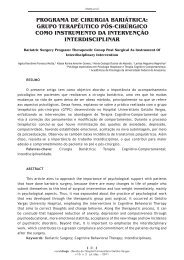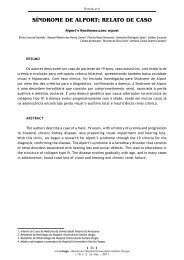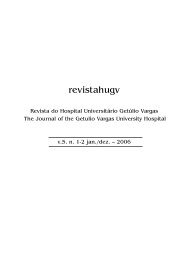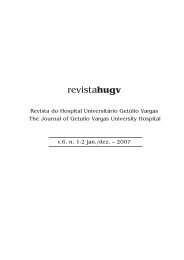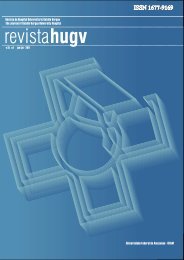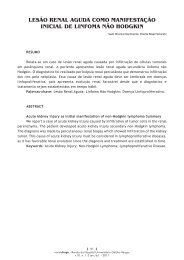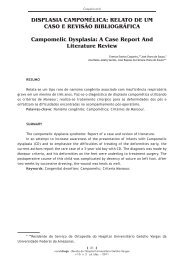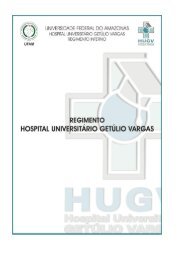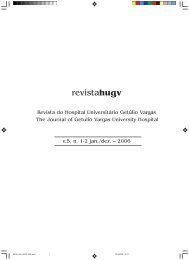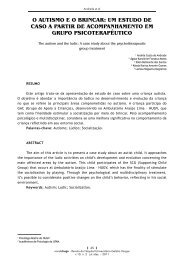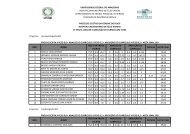Revista HUGV 2008 - Hospital Universitário Getúlio Vargas - Ufam
Revista HUGV 2008 - Hospital Universitário Getúlio Vargas - Ufam
Revista HUGV 2008 - Hospital Universitário Getúlio Vargas - Ufam
You also want an ePaper? Increase the reach of your titles
YUMPU automatically turns print PDFs into web optimized ePapers that Google loves.
MIRIAM RAQUEL ARDIGÓ WESTPHAL, NATASHA DA SILVA LEITÃO<br />
AVALIA<br />
ALIAÇÃ<br />
ÇÃO DOS PROTOC<br />
OCOL<br />
OLOS OS DE HIGIENE BUCAL<br />
NAS UNIDADES DE TERAPIA INTENSIVA DE HOSPI-<br />
TAIS PÚBLICOS E PRIVADOS<br />
*<br />
EVALUATION OF THE PROTOCOLS OF ORAL HYGIENE IN THE INTENSIVE CARE UNITS OF PUBLIC<br />
AND PRIVATE HOSPITALS<br />
Miriam Raquel Ardigó Westphal ** , Natasha da Silva Leitão ***<br />
RESUMO: Objetivo: Avaliar os protocolos preconizados para a higiene bucal de pacientes internados e intubados<br />
nas Unidades de Terapias Intensivas. Métodos: Trata-se de um estudo não-experimental descritivo que utilizou<br />
questionários, composto por perguntas fechadas e abertas. A amostra foi de 154 profissionais (55 médicos, 33<br />
enfermeiros e 66 técnicos/auxiliares) de quatro hospitais públicos e privados. Resultados: Afirmaram haver protocolo<br />
de higienização bucal para pacientes internados: 43,6% (24/55) dos médicos, 45,5% (15/33) dos enfermeiros e<br />
39,4% (26/66) dos auxiliares/técnicos, sendo 45,8% de instituições públicas e 39% privadas; e para pacientes<br />
intubados, 32,7% (18/55) dos médicos, 48,5% (16/33) dos enfermeiros e 31,8% (21/66) dos auxiliares/técnicos,<br />
sendo 34,7 e 36,6% de hospitais públicos e privados, respectivamente. A mediana da frequência de higiene bucal<br />
para todos os pacientes foi de três vezes, independente da profissão ou instituição. Os procedimentos mais usados,<br />
para pacientes internados nas instituições públicas e privadas, respectivamente, foram a escovação dental (45,5%<br />
e 28,1%), colutórios (18,2 e 21,9%), e para os pacientes intubados, foi o swab (68 e 70% ). O cloreto de cetilpiridino foi<br />
o colutório mais usado para pacientes internados (27,3 e 46,9%) e intubados (32 e 56,7%). Conclusão: Não há<br />
diferença entre a conduta de higiene bucal dos hospitais públicos e privados; e os protocolos adotados não estão de<br />
acordo com a literatura científica atual. Portanto, é essencial o desenvolvimento de programas educacionais e<br />
implementação de protocolos de higiene bucal na rotina hospitalar, visto que é um método eficaz na prevenção da<br />
pneumonia nosocomial e associada à ventilação mecânica.<br />
Palavras-chave: Higiene. Biofilme. Periodontite. Pneumonia.<br />
ABSTRACT: Objective: To evaluate the protocols recommended for oral care of patients hospitalized and intubated<br />
in the intensive care units. Methods: This is a non-experimental descriptive study that used questionnaires, consisting<br />
of closed and open questions. The sample of 154 professionals (55 doctors, 33 nurses and 66 technicians / assistants)<br />
from four public and private hospitals. Results: They said there was memorandum of oral hygiene in hospitalized<br />
patients: 43.6% (24/55) of doctors, 45.5% (15/33) of nurses and 39.4% (26/66) of assistants / technicians, and<br />
45.8% of public institutions and 39% private, and for intubated patients, 32.7% (18/55) of doctors, 48.5% (16/33) of<br />
nurses and 31.8% (21/66 ) of assistants / technicians, and 34.7 and 36.6% of public and private hospitals,<br />
respectively. The median frequency of oral hygiene for all patients was three times, regardless of profession or<br />
institution. The procedures most used for inpatients in public and private institutions, respectively, were brushing<br />
teeth (45.5% and 28.1%), colutórios (18.2 and 21.9%) and for patients intubated, was the swab (68 and 70%). The<br />
cetilpiridino chloride was used to colutório more inpatients (27.3 and 46.9%) and intubated (32 and 56.7%).<br />
Conclusion: There is no difference between the conduct of oral hygiene of public and private hospitals, and the<br />
protocols used are not in accordance with current scientific literature. Therefore, it is essential to the development of<br />
educational programs and implementation of protocols and oral hygiene in the hospital routine, since it is an<br />
effective method for prevention of nosocomial pneumonia and associated with mechanical ventilation.<br />
*<br />
Artigo elaborado com base na dissertação/tese de Miriam Raquel Ardigó Westphal, intitulada “AVALIAÇÃO DAS ATITUDES E CONHECIMENTO DOS PROFISSIONAIS DAS<br />
UNIDADES DE TERAPIA INTENSIVA SOBRE A RELAÇÃO ENTRE HIGIENE BUCAL, DOENÇA PERIODONTAL E PNEUMONIA” – Centro de Pós-Graduação/Centro de Pesquisas<br />
Odontológicas São Leopoldo Mandic, <strong>2008</strong> (154).<br />
**<br />
Especialista em Endodontia e Periodontia, Mestre em Periodontia, Professora auxiliar de Periodontia /<strong>Ufam</strong>. Rua Franco de Sá, 230, salas 406-407, Ed. Atrium, São Francisco<br />
– Manaus-AM. E-mail: mwestphal2109@hotmail.com – fone: (92) 3611-1133.<br />
***<br />
Odontóloga. Rua Via-Láctea, 1.085, sala 1.700, Ed. Palácio Adrianópolis – Conj. Morada do Sol. E-mail: natashaleitão@hotmail.com – fone: (92) 3236-2770.<br />
revistahugv<br />
– <strong>Revista</strong> do <strong>Hospital</strong> Universitário Getúlio <strong>Vargas</strong><br />
v. 7. n. 1-2 jan./dez. – <strong>2008</strong><br />
69




